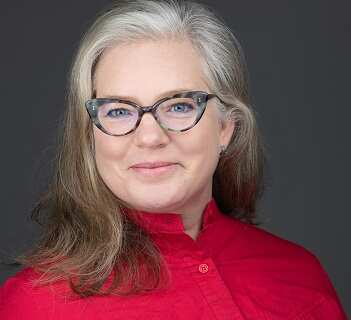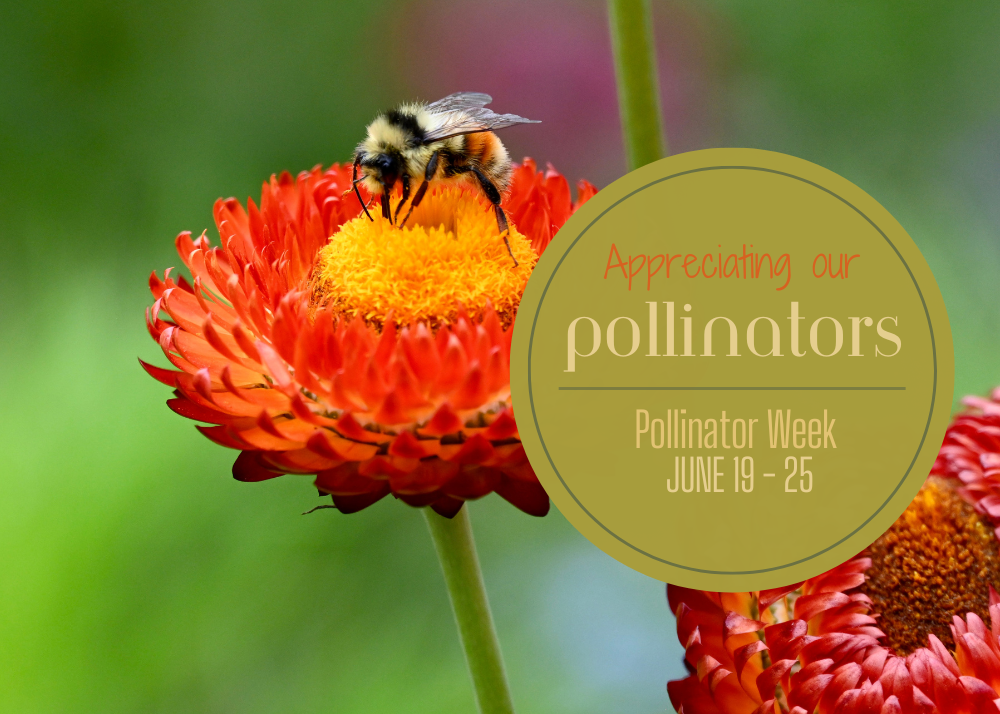Pollinator Week - June 19 - 25
by Emony Nicholls
This week we can express our gratitude to pollinators for making every third bite of food that we eat possible. The primary regional pollinators are bees, butterflies, moths, flies, wasps, beetles, ants and small mammals. We can support them by planting plants, ideally native plants (were here prior to European settlement) that provide habitat and food.
What is pollination?
Pollination is the transfer of pollen (male) on the anthers to the stigma (female), the pollen travels down the stigma and fertilise the eggs in the ovaries, becoming seed.
Pollen is a wonderful source of protein for insects, with carbohydrates coming from the sugars in the nectar.
Who are our local pollinators?
Honey bees are originally from Europe or Africa and have become an important part of our food security system. Their generalist pollination skills make these insects versatile, used for pollination of agricultural crops, orchards and vegetable gardens.
They live in the social community of a hive with a queen who the rest of the hive serve. They are the only bees who produce honey as a safety net to get them through food shortages. Unfortunately for them, honey is a sugary treat that everyone from Winnie the Pooh to you and me love to eat. None of our native bees produce honey that we can harvest.
Our native bees
Native bees don't sting, except Bumble bees if you squish them!
Our native bees may not be familiar to you but you already depend on them for some of your food. We manage a number of native bees for agriculture. Bumble bees are often used in greenhouses for buzz pollination of tomatoes, they vibrate at the right frequency for the tomatoes to release the pollen. Many of our fruit orchards use Mason bee, also known as blue orchard bees for their incredible efficiency in pollinating fruit flowers. Did you know that 300 mason bees can do the works of 90,000 honey bees? Mason bees have evolved specifically to fruit flowers over thousands of years- they are simply the best at it A female will visit 1,875 flowers to collect pollen and nectar to make a single ‘pollen loaf' of them mixed together before laying her egg on top where the larvae hatch and eat the meal left for them before spinning into their chrysalis for metamorphosis into adult bees. And she will lay up to 30 eggs. That's a lot of flower visits! There are now small mason bee houses for your garden so you can host them and have bigger and better fruits and vegetables.
Alfalfa leafcutters are used for alfalfa pollination for animal forage over winters. They are housed in those little “tents” in agricultural fields. If you have holes in your rose leaves, these girls are responsible for that. They use the leaves to roll up and wrap their ‘loafs' in them and use chewed up leaf to create a paste that seals the nest.
Any of our squashes, pumpkins or melons are often pollinated by the squash bees who specialise in pollinating the flower type.
Butterflies
BC has the largest diversity of the provinces in Canada with 187 species in BC. Butterflies and moths are good pollinators because their hairy bodies land directly on the flower, attracting the pollen grains through static charge.
The female typically lays the eggs on a leaf which hatches into a caterpillar and feeds on the host plant. Once the butterfly has emerged as an adult it then feeds on nectar plants. Both stages often have very host specific plants. These nectar plants can also cross over as larval hosts: ocean spray, lupine, stinging nettle, red-flowering currant and sedums. Butterflies prefer flowers that are pink, red, purple, or yellow and that are open all day with a narrow tube and spur but also with a wide landing pad for them. Consider replacing your invasive butterfly bush with mock orange, a wonderful native nectar plant for butterflies. Also, include a dish of water that is changed regularly during the dry season.
Moths
Moths are generally quite unknown to people despite there being an astonishing 2000 species in the province. I suppose we can't be surprised since we never see them! Moths are primarily nocturnal with the sphinx and hawk moths being the few species that come out during the day.
Moths are essentially butterflies of the night and share the same life cycle but with different preferred larval and nectar hosts. The noted difference between moths and butterflies is that some moths are born without mouths and can't feed, they procreate and die. Moths are eaten by birds, bats, rodents, reptiles, fish and spiders- showing their value in a healthy ecosystem. Very little data is available for population numbers and trends, making conservation challenging. They are under the same environmental pressures as other insects including from pesticides that target larvae. Moths are attracted to flowers that are strongly sweet smelling, open in late afternoon or night, and are typically white or pale coloured such as woolly sunflower, salal, Saskatoon berry, evergreen huckleberry or salmonberry.
Hummingbird moths or hawk moths are less known and very little information available on them but they behave much like moths or butterflies
Flower Flies
Hover flies, syrphid flies or flower flies are often mistaken for bees due to their mimicry of bees or wasps with their black and white or yellow and black stripes to stop predators eating them.
They are often seen hovering over your arms during the summers wanting to lick the salts from your skin but don't smack them! They don't sting and are just pretending to be wasps. Flower flies are a lesser known pollinator with smooth bodies and no deliberate pollen collecting however they visit many flowers and are still pollinators.
Wasps
Believe it or not, bees evolved from wasps but chose the vegetarian lifestyle of consuming pollen and nectar rather than the carnivorous ways of wasps. They also don't have the hairs on their bodies to carry the pollen, their smooth bodies are like beetles and flower flies, these animals don't receive the usual credit of being a pollinator but are nonetheless pollinators.
They particularly love eating the pollen for protein. Wasps are best known for pollinating figs.
Hummingbirds
Our region's most common hummingbird is Anna's hummingbird who lives here year-round and we seasonally have the gorgeous Rufous Hummingbird. When planning gardens for these flying jewels, it is important to have a succession of flowers throughout the growing season to ensure a constant nectar source. Don't be afraid to supplement them with a feeder, especially over the winter. Be sure to clean it regularly as mold can grow in the sugar-rich environment.
Typically, people say that hummingbirds prefer red tubular flowers but in my experience they will visit all flowers! To attract these birds, grow red columbine, red flowering currant, Pacific bleeding heart, salmonberry or orange honeysuckle.
Beetles- There are only a few flowers that are pollinated by beetles but they do visit flowers and tend to eat the flower parts.
Bats- sadly, we do not have bats that pollinate in Canada, the bats who pollinate are found in the southern USA and into Mexico and the tropics.
Others not discussed here, ants, midges and small mammals
In summary, let's celebrate pollinators by providing plants they can lay their eggs on, nest in their stems and drink their flower nectar so these hard working insects can continue to make food and beautiful flowers for us and our ecosystem.
Written by Emony Nicholls
 Emony has worked as an environmental consultant, entrepreneur and biologist for the last 25 years. In Ontario, she owned and operated a native plant nursery designing and providing plants for ecological restoration projects in the most easterly tallgrass prairie in North America. Her graduate research was on the relationship between pollinators and plants and how it drives the evolution of life history traits in plants (age, sex, growth, etc.). As part of her research, she did taxonomic identification of the native pollinators and fell in love with them, their diversity and individual beauty. She is now on a mission to educate others about them in the hopes that they will fall in love with them too! She recently left work with the provincial government as a biologist and now lives and works on Salt Spring Island. Emony's new business includes giving public talks and offering garden consultations and design for ecological gardens like pollinator or drought resistant gardens.
Emony has worked as an environmental consultant, entrepreneur and biologist for the last 25 years. In Ontario, she owned and operated a native plant nursery designing and providing plants for ecological restoration projects in the most easterly tallgrass prairie in North America. Her graduate research was on the relationship between pollinators and plants and how it drives the evolution of life history traits in plants (age, sex, growth, etc.). As part of her research, she did taxonomic identification of the native pollinators and fell in love with them, their diversity and individual beauty. She is now on a mission to educate others about them in the hopes that they will fall in love with them too! She recently left work with the provincial government as a biologist and now lives and works on Salt Spring Island. Emony's new business includes giving public talks and offering garden consultations and design for ecological gardens like pollinator or drought resistant gardens.



